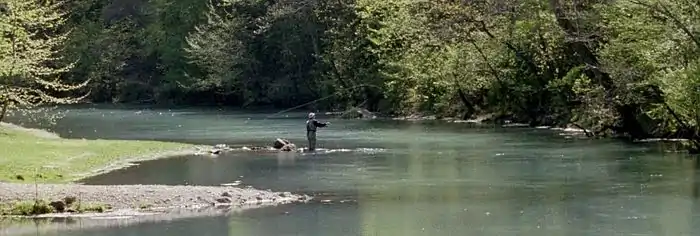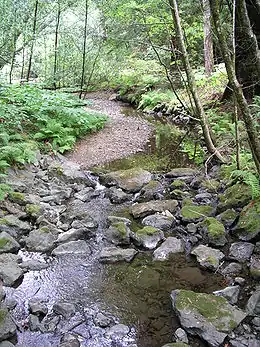Spring (hydrology)
A spring is a point at which water flows from an aquifer to the Earth's surface. It is a component of the hydrosphere.
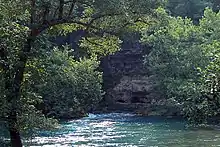
Formation
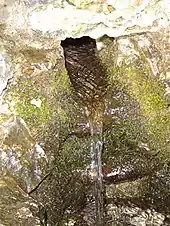
A spring may be the result of karst topography where surface water has infiltrated the Earth's surface (recharge area), becoming part of the area groundwater. The groundwater then travels through a network of cracks and fissures—openings ranging from intergranular spaces to large caves. The water eventually emerges from below the surface, in the form of a karst spring.
The forcing of the spring to the surface can be the result of a confined aquifer in which the recharge area of the spring water table rests at a higher elevation than that of the outlet. Spring water forced to the surface by elevated sources are artesian wells. This is possible even if the outlet is in the form of a 300-foot-deep (91 m) cave. In this case the cave is used like a hose by the higher elevated recharge area of groundwater to exit through the lower elevation opening.
Non-artesian springs may simply flow from a higher elevation through the earth to a lower elevation and exit in the form of a spring, using the ground like a drainage pipe.
Still other springs are the result of pressure from an underground source in the earth, in the form of volcanic activity. The result can be water at elevated temperature such as a hot spring.
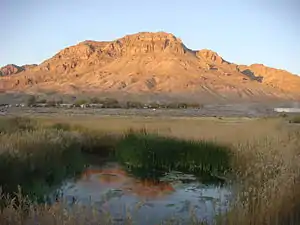
The action of the groundwater continually dissolves permeable bedrock such as limestone and dolomite, creating vast cave systems.[1]
Types
- Depression spring, is a spring which occurs along a depression, such as the bottom of alluvial valleys, basins, or valleys made of highly permeable materials. [2]
- Contact Spring, which occurs along the side of a hill or mountain is created when the groundwater is underlaid by an impermeable layer of rock or soil known as an aquiclude or aquifuge [2]
- Fracture, joint, or tubular spring, occurs when groundwater running along an impermeable layer of rock meets a crack (fracture) or joint in the rock.[2]
- Artesian spring, is a spring that typically occurs at the lowest point in a given area. An artesian spring is created when the pressure for the groundwater becomes greater than the pressure from the atmosphere. In this case the water is pushed straight up out of the ground.[3]
- Wonky holes, which are freshwater submarine exit points for coral and sediment covered sediment filled old river channels.[4]
- Karst spring
- Hot springs, has a water temperature significantly higher than the mean air temperature of the surrounding area.[5]
Flow
Spring discharge, or resurgence, is determined by the spring's recharge basin. Factors that affect the recharge include the size of the area in which groundwater is captured, the amount of precipitation, the size of capture points, and the size of the spring outlet. Water may leak into the underground system from many sources including permeable earth, sinkholes, and losing streams. In some cases entire creeks seemingly disappear as the water sinks into the ground via the stream bed. Grand Gulf State Park in Missouri is an example of an entire creek vanishing into the groundwater system. The water emerges 9 miles (14 km) away, forming some of the discharge of Mammoth Spring in Arkansas. Human activity may also affect a spring's discharge—withdrawal of groundwater reduces the water pressure in an aquifer, decreasing the volume of flow.[6]
Classification
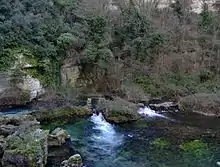
Springs are often classified by the volume of the water they discharge. The largest springs are called "first-magnitude", defined as springs that discharge water at a rate of at least 2800 liters or 100 cubic feet (2.8 m3) of water per second. Some locations contain many first-magnitude springs, such as Florida where there are at least 27 known to be that size; the Missouri and Arkansas Ozarks, which contain 10[7][6] known of first-magnitude; and 11[8] more in the Thousand Springs area along the Snake River in Idaho. The scale for spring flow is as follows:
| Magnitude | Flow (ft3/s, gal/min, pint/min) | Flow (L/s) |
|---|---|---|
| 1st magnitude | > 100 ft3/s | 2800 L/s |
| 2nd magnitude | 10 to 100 ft3/s | 280 to 2800 L/s |
| 3rd magnitude | 1 to 10 ft3/s | 28 to 280 L/s |
| 4th magnitude | 100 US gal/min to 1 ft3/s (448 US gal/min) | 6.3 to 28 L/s |
| 5th magnitude | 10 to 100 gal/min | 0.63 to 6.3 L/s |
| 6th magnitude | 1 to 10 gal/min | 63 to 630 mL/s |
| 7th magnitude | 2 pint to 1 gal/min | 8 to 63 mL/s |
| 8th magnitude | Less than 1 pint/min | 8 mL/s |
| 0 magnitude | no flow (sites of past/historic flow) |
Water content
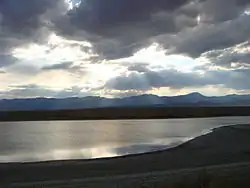
Minerals become dissolved in the water as it moves through the underground rocks. This mineral content is referred to as total dissolved solids (TDS). This may give the water flavor and even carbon dioxide bubbles, depending on the nature of the geology through which it passes. This is why spring water is often bottled and sold as mineral water, although the term is often the subject of deceptive advertising. Mineral water contains no less than 250 parts per million (ppm) of tds. Springs that contain significant amounts of minerals are sometimes called 'mineral springs'. (Springs without such mineral content, meanwhile, are sometimes distinguished as 'sweet springs'.) Springs that contain large amounts of dissolved sodium salts, mostly sodium carbonate, are called 'soda springs'. Many resorts have developed around mineral springs and are known as spa towns. Mineral springs are alleged to have healing properties. Soaking in them is said to result in the absorption of the minerals from the water.
Water from springs is usually clear. However some springs may be colored by the minerals that are dissolved in the water. For instance, water heavy with iron or tannins will have an orange color.[1]
In parts of the United States a stream carrying the outflow of a spring to a nearby primary stream may be called a spring branch or run. Groundwater tends to maintain a relatively long-term average temperature of its aquifer; so flow from a spring may be cooler than other sources on a summer day, but remain unfrozen in the winter. The cool water of a spring and its branch may harbor species such as certain trout that are otherwise ill-suited to a warmer local climate.
Uses
Springs have been used for a variety of human needs - including drinking water, domestic water supply, irrigation, mills, navigation, and electricity generation. Modern uses include recreational activities such as fishing, swimming, and floating; therapy; water for livestock; fish hatcheries; and supply for bottled mineral water or bottled spring water. Springs have taken on a kind of mythic quality in that some people believe, falsely, that springs are healthy sources of drinking water. They may or may not be. In order to know how to use a spring appropriately, whether for a mineral bath or drinking water you must perform a comprehensive water quality test. Springs that are managed as spas will already have such a test.
Springs are often used as sources for bottled water. When purchasing bottled water labelled as spring water you can often find the water test for that spring on the website of the company selling it. Just because a spring is bottled and sold as spring water does not mean that it is contaminant free. It is best to search out a water test or purchase one yourself before making a habit of drinking regularly from any spring.
Sacred springs
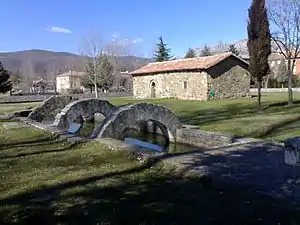
A sacred spring, or holy well, is a small body of water emerging from underground and revered either some religious context: Christian and/or pagan and/or other. The lore and mythology of ancient Greece was replete with sacred and storied springs—notably, the Corycian, Pierian and Castalian springs. In medieval Europe, pagan sacred sites frequently became Christianized as holy wells. The term "holy well" is commonly employed to refer to any water source of limited size (i.e. not a lake or river, but including pools and natural springs and seeps), which has some significance in local folklore. This can take the form of a particular name, an associated legend, the attribution of healing qualities to the water through the numinous presence of its guardian spirit or of a Christian saint, or a ceremony or ritual centred on the well site. Christian legends often recount how the action of a saint caused a spring's water to flow - a familiar theme especially in the hagiography of Celtic saints.
Notable springs
Asia:
- Baotu Spring, Jinan, Shandong, China ("City of Springs")
- Gihon Spring, Jerusalem
- Wolmyeongdong Spring, South Korea
- Al-Hasa Springs, Saudi Arabia
- Beitou District, Taiwan
- Su'ao Cold Spring, Yilan, Taiwan
Europe:
- Vrelo Bosne, Ilidža, Bosnia
- Farmakas, Troodos Mountains, Cyprus
- Bath, England
- Buxton, England
- Harrogate, England
- Kiikunlähde,[9] Hollola, Finland
- Fontaine de Vaucluse, France
- 20-Pipe Well, Altleiningen, Germany
- Aachtopf, Germany
- Sachsenbrunnen, Bad Harzburg, Germany
- Castalian Spring, Delphi, Greece
- Pierian Spring, Pieria, Greece
- Spring of Juturna, Roman Forum, Rome, Italy
- Afyonkarahisar, Turkey
- Termal, Yalova, Turkey
North America:
- Ice River Spring, Nunavut, Canada
- Bagby Hot Springs, Oregon
- Barton Springs, Texas
- Berkeley Springs, West Virginia
- Bennett Spring, Missouri
- Big Spring, Texas
- Big Spring, Missouri
- Big Springs, Idaho
- Blue Spring, Florida
- Comal Springs, Texas
- Colorado Springs, Colorado
- Giant Springs, Montana
- Glenwood Springs, Colorado
- Greer Spring, Missouri
- Homosassa Springs, Florida
- Idaho Springs, Colorado
- Mammoth Spring, Arkansas
- Maramec Spring, Missouri
- Montezuma Well, Arizona
- Niagara Springs, Idaho
- Poland Spring, Maine
- Kitch-iti-kipi, Michigan
- Las Estacas, Morelos
- Little Salt Spring, Florida
- Radium Hot Springs, British Columbia
- Rainbow Springs, Florida
- San Marcos Springs, Texas
- Sanlando Springs, Florida
- Saratoga Springs, New York
- Saratoga, Wyoming
- Silver Springs, Florida
- Steamboat Springs, Colorado
- Wakulla Springs, Florida
- Warm Springs, Georgia
- Wekiwa Springs, Florida
- Weeki Wachee Springs, Florida
- Ojo Caliente Hot Springs, New Mexico
Oceania:
- Hanmer Springs, Canterbury, New Zealand
- Hot Water Beach, Waikato, New Zealand
- Innot Hot Springs, Queensland, Australia
- Paeroa, Waikato, New Zealand
- Te Waikoropupu Springs, Tasman, New Zealand
- Tjuwaliyn (Douglas) Hot Springs, Northern Territory, Australia
South America:
See also
- Body of water – Any significant accumulation of water, generally on a planet's surface
- Chalk stream
- Ciénega – A wetland system unique to the American Southwest
- Drinking water – water safe for consumption
- Fountain – Architecture which pours water into a basin or jets it into the air
- Geyser – Hot spring characterized by intermittent discharge of water ejected turbulently and accompanied by steam
- Holy well
- Hot spring – Spring produced by the emergence of geothermally heated groundwater
- Rhythmic spring, also known as Intermittent spring
- Karst spring
- Lake – large body of relatively still water
- List of hot springs in Japan – Wikipedia list article
- List of hot springs in the United States – Wikipedia list article
- List of hot springs in the world – Wikipedia list article
- List of Ozark springs
- List of spa towns
- List of major springs in Florida – Wikipedia list article
- Mineral water
- Petroleum seep
- Pond – A relatively small body of standing water
- Soakage
- Spa town – Specialized resort town situated around a mineral spa
- Spring supply
- River source – Starting point of a river
- Thousand Springs State Park
- Water cycle – Continuous movement of water on, above and below the surface of the Earth
- Well – Excavation or structure to provide access to groundwater
References
Citations
- "Springs - The Water Cycle, from USGS Water-Science School". ga.water.usgs.gov. Archived from the original on 9 May 2009.
- "https://directives.sc.egov.usda.gov/OpenNonWebContent.aspx?content=26985.wba". directives.sc.egov.usda.gov. Retrieved 29 September 2020. External link in
|title=(help) - Westbrook, Cherie J. (2017). "Heads Above Water: The Inside Story of the Edwards Aquifer Recovery Implementation Program by Robert L. Gulley". Great Plains Research. 27 (2): 143. doi:10.1353/gpr.2017.0022. ISSN 2334-2463. S2CID 133972692.
- Horstman, Mark (18 May 2006). "Wonky Holes". Catalyst transcript. Australian Broadcastiing Corporation. Retrieved 17 April 2019.
- cite web=https://www.britannica.com/science/spring-water Britannica encyclopedia}
- "USGS Surface-Water Data for Missouri". waterdata.usgs.gov.
- Vineyard and Fender, 1982. p. 12
- "Archived copy". Archived from the original on 12 December 2012. Retrieved 10 May 2009.CS1 maint: archived copy as title (link)
- Stunning turquoise natural spring Kiikunlähde at Hollola
Further reading
- LaMoreaux, Philip E.; Tanner, Judy T, eds. (2001), Springs and bottled water of the world: Ancient history, source, occurrence, quality and use, Berlin, Heidelberg, New York: Springer-Verlag, ISBN 3-540-61841-4
- Springs of Missouri, Vineyard and Feder, Missouri Department of Natural Resources, Division of Geology and Land Survey in cooperation with U.S. Geological Survey and Missouri Department of Conservation, 1982
- Cohen, Stan (Revised 1981 edition), Springs of the Virginias: A Pictorial History, Charleston, West Virginia: Quarrier Press.
External links
| Wikimedia Commons has media related to Springs. |
